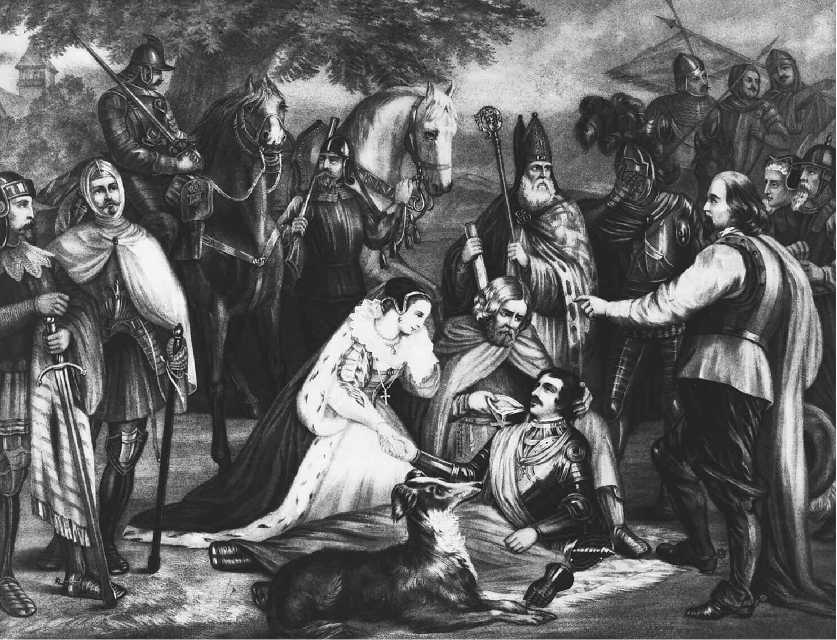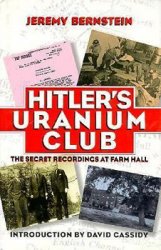Catholic queen of Scotland, twice forced to abdicate her throne, pretender to the English throne, executed by her cousin Queen Elizabeth I On 8 December 1542, Mary Stuart was born to Mary of Guise-Lorraine and James V of Scotland. Six days later, she succeeded her
Father and on 9 September 1543 was crowned queen. As her paternal grandmother was Margaret Tudor, Henry VIII’s sister, Mary also possessed English succession rights. In July 1543, her governors approved the Treaties of Greenwich, which arranged for her marriage to Henry’s heir, the future Edward VI, and her move to England at her tenth birthday. After Scotland repudiated the treaties in December, Henry and then Edward’s Lord Protector, Edward, duke of Somerset, attempted to abduct Mary in raids called the “Rough Wooing.” In 1548, she escaped to France as the betrothed of Henry Il’s son, Francis, leaving French forces occupying Scotland.
In France
In France, Mary received a humanist education, acquiring a basic grounding in Latin. She also became fluent in French and Italian and learned to sing, dance, play musical instruments, and embroider. Two favorite outdoor pastimes were horseback riding and hunting. On 24 April 1558, she wed Francis, to whom the Scottish parliament granted the title of king matrimonial. After Elizabeth I’s accession as queen of England in November, Mary quartered the English arms with those of Scotland and France, signaling that her hereditary claims were superior to her cousin’s, whom Catholics viewed as illegitimate.
In August 1559, Francis succeeded his father as king. Meanwhile, the Protestant Reformation garnered support in Scotland by denouncing the French domination that their queen’s marriage to Francis legitimized. In 1560, English invaders in Scotland, supporting the reformers, signed the Treaty of Edinburgh with the French forces, arranging for both armies to depart and for Mary to cease bearing England’s arms. Concerned that the treaty would negate her English claims, Mary never ratified it.
In Scotland
After Francis died on 5 December 1560, Mary quit bearing England’s arms and decided to return home. When she reached Scotland in August 1561, Protestants controlled her govern-ment. Although refusing to validate the Reformation acts outlawing the mass and papal authority, she enforced them publicly while retaining Catholic services in her chapel.
During her short personal rule, she consulted with her privy councilors, summoned five parliaments or conventions, and governed competently. As Scottish sovereigns were expected to be seen dispensing justice throughout the realm, she went on several progresses and held a justice-ayre at Jedburgh. Her court was as culturally significant as her father’s; it inspired the Bannatyne Manuscript, a collection of invaluable late medieval Scottish poetry, and attracted George Buchanan and other scholars.
In 1563 at Elizabeth’s suggestion, Mary agreed to wed Robert Dudley, earl of Leicester, but only after gaining legislative validation of her English claims, which HenryVIII omitted from his will, limiting the succession. While negotiating this match, she was also secretly proposing to wed Don Carlos, Philip II of Spain’s heir and hoping to move to the Netherlands, which he would rule as regent. In May 1565, upon learning that neither alliance could be arranged, she decided to marry Henry, Lord Darnley, an English citizen who came to Scotland to acquire his family’s forfeited estates. A lukewarm Catholic born in December 1545, Darnley possessed claims to the English throne through his maternal grandmother, Margaret Tudor. After Elizabeth protested Mary’s plans to wed Darnley, she postponed the wedding and asked for a conference concerning her marriage, a request Elizabeth refused. Having granted Darnley the title of king, Mary wed him on 29 July, apparently for his lineage and not for love. Her illegitimate brother, James Stewart, earl of Moray, orchestrated a failed rebellion to challenge her marriage, called the Chaseabout Raid.
That his royal status did not embody real governing powers troubled Darnley because he possessed strong succession rights as James II’s

Mary, Queen of Scots, comforts a dying man after the Battle of Langside. Painting by F Hartwich. (Library of Congress)
Descendant. Without public authority, he also lacked the patriarch’s position as head of his household. Having conspired to usurp Mary’s throne and murder David Riccio, her secretary and rumored lover, on 9 March 1566 he introduced into his pregnant wife’s chamber at Holyrood assassins, who imprisoned her and killed Riccio. Later, Mary somehow regained her husband’s trust, and they escaped together. Afterward, he angered his allies by denying publicly any involvement in the conspiracy.
On 19 June, Mary gave birth to their son, James, and on 17 December, held a gala Roman Catholic christening for him at Stirling. Darn-ley absented himself from the ritual, primarily because the representatives of Elizabeth, his son’s godmother, would not recognize his royal status. In late December, Darnley contracted smallpox en route to Glasgow. The next month,
Mary visited her estranged husband; they became reconciled, and she returned him to a lodge at Kirk o’Field to convalesce until he could safely interact with their son at Holyrood. On 10 February 1567 about 2:00 a. m., various individuals alienated by Darnley blew up the lodge. He escaped outside only to be smothered by assassins. One of the rumored murderers was James Hepburn, earl of Bothwell, who was tried for the crime but acquitted for lack of evidence. On 24 April, as Mary returned fTom visiting her son at Stirling, the married earl abducted and raped her. After his wife, Jane Gordon, obtained a divorce, Mary agreed to wed Bothwell in a Protestant service to protect her honor, thereby prompting some of her subjects to revolt against her authority. After Bothwell fled, she surrendered to the rebels, who imprisoned her at Lochleven, where she miscarried twins sired by
Bothwell and abdicated her throne to James. In May 1568, after she escaped, the army of Moray, her son’s regent, defeated her forces and prevented her from taking refuge in Dumbarton Castle. She fled to England, seeking Elizabeth’s aid to regain her authority.
English Captivity and Death
At an English inquiry in late 1568 concerning whether she colluded in her husband’s death, Moray introduced the Casket Letters, reputedly copies of love messages she wrote to Bothwell before Darnley’s death. The original French versions, if they ever existed, have not survived, and the copies are likely forgeries. Al-though the commissioners failed to find her guilty, she remained in captivity, dwelling until 1584 mostly at Sheffield Castle under George Talbot, earl of Shrewsbury’s custodianship. After agreeing to wed Thomas Howard, duke of Norfolk, who supported her English claims, Mary attempted unsuccessfully to divorce Bothwell, who survived in a Danish prison until 1578. Meanwhile, in 1572, Norfolk was executed for treason following two abortive conspiracies favoring his marriage to her: the Catholic Rising in 1569 and the Ridolfi Plot in 1571.
The conspiracies led Shrewsbury to confine Mary to her quarters, although he later allowed her to go on walks and short rides under heavy guard. Indoors, she occupied herself with embroidering and reading. Shrewsbury denied her a priest, but in late 1584 a cleric secretly entered her household. Because she suffered from a chronic illness, perhaps porphyria, which she claimed her imprisonment exacerbated, she was allowed to visit Shrewsbury’s Buxton medicinal baths several times. She never ceased longing for liberation and kept in contact with agents in France, who conspired with her Guise relatives and with Philip of Spain to invade England and free her. In 1581, she also began to negotiate successfully for a treaty to associate with her son, James VI, in the governance of Scotland because she anticipated that it might allow her greater freedom in England.
In 1584, Englishmen began endorsing a Bond of Association, which required its signatories to assassinate those who attempted to murder Elizabeth and the English claimants for whom they plotted. Although realizing she was the target, Mary signed it, convinced that her jailors would kill her when Elizabeth died, even of natural causes. Its later statutory form substituted a trial for the vigilantism.
After transferring Mary to Chartley in 1585, Sir Francis Walsingham, Elizabeth’s principal secretary, who broke Mary’s secret code, read and then forwarded her correspondence, including Sir Anthony Babington’s proposal to free her first before assassinating Elizabeth. Mary’s ciphered response, which is not extant, likely detailed the troops required for her liberation and ignored the plans for Elizabeth’s mur-der. Walsingham had Mary’s entire ciphered response copied and forwarded that version to Babington. The copier of Mary’s letter probably added the phrases that made it appear she agreed to Elizabeth’s murder to gain her freedom, thus altering Babington’s original sequence. Walsingham hoped this altered timing would convince Elizabeth to consent to Mary’s execution.
By authority of the Statute of Association, Elizabeth appointed a commission to try Mary at Fotheringhay. Initially, Mary refused to accept its jurisdiction but finally decided to appear before it to deny she agreed to Elizabeth’s murder. After the commission found her guilty, Elizabeth reluctantly signed the death warrant. Despite the queen’s withholding authorization for its delivery, William Davison, her secretary, secretly carried it to Fothering-hay. On 8 February 1587, Mary calmly entered the execution chamber supported by two soldiers, because her disease had crippled her. Before dying, she pardoned her enemies and prayed to Jesus Christ for absolution. It took two blows of the axe and the sawing of a sinew for the executioner to complete his task. She was buried at Peterborough, but James later transferred her corpse to Westminster Abbey.
Retha Warnicke
See also Elizabeth I; Grey, Jane; Marie of Guise; Power, Politics, and Women; Religious Reform and Women.
Bibliography
Fraser, Antonia. Mary Queen of Scots. New York: Delacorte, 1994.
Lynch, Michael, ed. Mary Stewart in Three Kingdoms. London: Blackwell, 1988.
Merriman, Marcus. The Rough Wooings: Mary Queen of Scots, 1541—51. Edinburgh:TuckweII, 2000.
Warnicke, Retha M. Mary Queen of Scots. London: Routledge, forthcoming.
Watkins, Susan. Mary Queen of Scots. New York: Thames and Hudson, 2001.
Wormald, Jenny. Mary Queen of Scots: Politics, Passion and a Kingdom Lost. NewYork:Tauris Park, 2001.




 World History
World History









